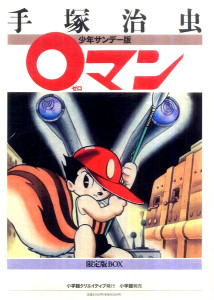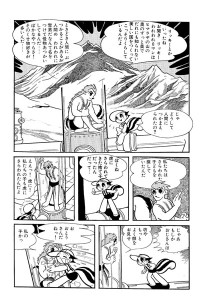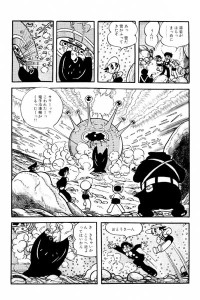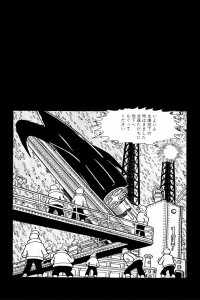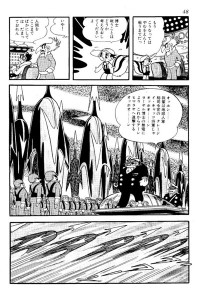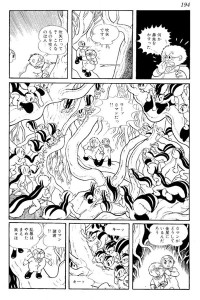Zero Men (Manga)
Also known as 0マン (0 Man)
| English Title: | Zero Men |
| In English? | No |
| Japanese Title: | 0マン (0 Man) |
| Type: | Ongoing Serial |
| Original run: | 1959/09/13 – 1960/12/11 |
| Published in: | Weekly Shonen Sunday 週刊少年サンデー |
| Published by: | Shogakukan |
| Volumes: | 4 (MT-021 | MT-022 MT-023 | MT-024) |
Zero Men (1959-60) was Tezuka’s follow-up to Dr. Thrill (1959) in Weekly Shonen Sunday, and was originally serialized from September 13, 1959 to December 11, 1960. Much like The Adventure of Rock (1952-54), Captain Ken (1960-61) and Astro Boy (1952-68), Zero Men (1959-60) explores a favoured theme of Tezuka’s, the struggle to bridge the gap between two opposing cultures – in this case human being’s with tails.
What it’s about
The story begins as a handgun shootout rages between two pilots from opposing countries that have been shot down and forced to land in a wasteland near the Himalayan Mountains. As they continue firing at one another, they notice the sudden appearance of a tiger carrying a human baby in its jaws. The two agree to a truce while they rescue the baby. After the tiger is dispatched the two make a gentleman’s agreement that whoever survives the shootout will look after the baby, and resume their conflict. In the end, the Japanese soldier prevails, but when he collects the baby, he is surprised to find it has a massive tail. Naming the baby Rikiya, or “Ricky” for short, he is brought back to Tokyo and raised as a human being, despite being one of the “Zero Men” – an advanced underground civilization of squirrel-like beings that live under the Himalayas.
Led by their Grand Priest, an absolute dictator with a hatred of humanity, the Zero Men use their advanced technology to invade Tokyo and transform it into an inhuman futuristic city and a base from which to launch their plans for world domination. However, although he is a Zero Man by birth, having been raised by humans, Ricky decides to do what he can to help humanity.
And so, Ricky and his friends infiltrate and destroy the Zero Men’s secret factory. This, however, causes chaos underground and eventually sets off Mt. Fuji. In an attempt to stop the volcanic eruption, the Zero Men use an electronic freezing machine, but a mistake in the settings actually throws the Earth into a new ice age. This, of course, is a much more difficult situation for the humans, as the Zero Men are able to survive quite comfortably in a climate with temperatures that plummet to -50oC.
Faced with these hardships, the humans launch an ambitious plan to abandon Earth to the Zero Men and colonize Venus. Yet, shortly after they arrive, the humans encounter the humanoid ancestors of the Zero Men. Meanwhile, back on Earth, leads a guerrilla war against the Zero Men. Although they are at a severe disadvantage, when the Zero Men oppressed by the Grand Priest’s dictatorship stage a revolution, the tide turns and the Grand Priest is exiled.
As the Earth’s climate begins to realign itself, with Mother Nature throwing off the effects of the artificial ice age, the Venus expeditionary force abandons their plans and return to Earth. There they find the Zero Men, now led by a revolutionary government, pursuing a peaceful coexistence with the humans. Ricky, now wearing an artificial tail to replace his own tail that was lost in battle, becomes the ambassador plenipotentiary, bridging the gap between the humans and the Zero Men.
Of course, peaceful coexistence is easier said than done. When a group of humans come into the possession of a “death-ray” machine, they go on a rampage, destroying the Zero Men’s underground world. Saying “we have decided not to bother with humans anymore”, the Zero Men leave Earth to the humans and return to Venus, the home of their ancestors.
And so, after the Zero mean leave, the Earth returns to a state of relative peace, almost as if nothing had ever happened. However, given humanity’s apparent unwillingness to learn to live peacefully, the closing message is clear – “If mankind kills itself through wars, then Zero Men might return to earth again.”
What you should know
Zero Men (1959-60) followed Dr. Thrill (1959) in Weekly Shonen Sunday. Yet while Dr. Thrill (1959) had begun as a collection of stand-alone stories that eventually transformed into a long-form story serial, Tezuka constructed Zero Men (1959-60) as a lengthy science-fiction story from the beginning.
Much like Nextworld (1951), The Adventure of Rock (1952-54), Astro Boy (1952-68), and later Captain Ken (1960-61), Zero Men (1959-60) is part of Tezuka’s collection of science fiction stories where he explores an encounter between two different sentient races, and the struggles of a champion caught in the middle who is trying to prevent the inevitable degeneration into all-out war.
While certainly similar to Astro Boy (1952-68), with the young hero of the story caught between two worlds, Zero Men (1959-60) more closely resembles Next World (1951). In Nextworld (1951), a conflict arises between humans and the Fumoon, a tiny intelligent race which develops rapidly in the depths of Australia, a mutation caused by human pollution. In both these cases, the races coming into conflict are both natives to Earth, but find themselves unable to coexist with one another, despite the fact that the many animal races on our planet have no difficulty coexisting. The similar endings to both stories, concluding with one of the races declaring that coexistence is impossible and leaving Earth forever, project a pessimism about the possibility of true tolerance ever being achieved, since peace is only possible through separation.
This is evident in the title “Zero Men,” which mean human beings at degree zero.
Tezuka seems to suggest that there are no easy solutions to racial prejudices. We cannot hope to see change in the course of a single story but must look to change only in the long-run. However, even in Tezuka’s masterwork Phoenix (1967-88), a story which takes place not over months or years but over the many millennia of human history from beginning to end, intolerance and war remain even in the furthest-flung chapter, “Future”.
Yet two sources of optimism remain. The first is the perpetual progress of the quest for understanding of the cycle of life; explored in characters such as Saurta in Phoenix (1967-88) who journeys through many incarnations, each time learning more about the cycles of life and death; and in stories such as Buddha (1972-83). The second, far warmer and more approachable, are the incorruptible heroes, such as Ricky, Kenichi and especially Astro Boy, who continue to hope and to work toward peace and understanding, and will never waver in their infectious faith that friendship is possible in all circumstances. It is a good infection to catch.
As with many of Tezuka’s stories, although they are technically intended to be children’s literature, their content is quite serious and often extremely dark. Zero Men (1959-60) is no exception, it features explicit depictions of murder, slavery, war, racial intolerance, political corruption, global destruction and genocide, but describe at a level that children can understand. Tezuka’s willingness to tackle these serious real-world problems is a hallmark of his work, and can be traced from his earlier works, such as Zero Men (1959-60), through to his more adult, real-world, treatment of them in Ayako (1972-73), Phoenix (1967-88), and his Second World War tale, Message to Adolf (1983-85).

